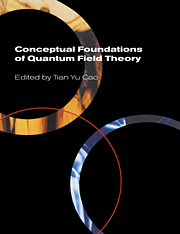Book contents
- Frontmatter
- Contents
- List of contributors
- Preface
- Photographs of the conference
- Introduction: Conceptual issues in quantum field theory
- Part One Philosophers' interest in quantum field theory
- Part Two Three approaches to the foundations of quantum field theory
- Part Three
- Part Four Mathematics, statistics and quantum field theory
- Part Five Quantum field theory and space-time
- Introduction
- 12 Quantum field theory and space-time – formalism and reality
- 13 Quantum field theory of geometry
- 14 ‘Localization’ in quantum field theory: how much of QFT is compatible with what we know about space-time?
- 15 Comments
- Part Six
- Part Seven Renormalization group
- Part Eight Non-Abelian gauge theory
- Part Nine The ontology of particles or fields
- Part Ten
- Name index
- Subject index
14 - ‘Localization’ in quantum field theory: how much of QFT is compatible with what we know about space-time?
Published online by Cambridge University Press: 22 September 2009
- Frontmatter
- Contents
- List of contributors
- Preface
- Photographs of the conference
- Introduction: Conceptual issues in quantum field theory
- Part One Philosophers' interest in quantum field theory
- Part Two Three approaches to the foundations of quantum field theory
- Part Three
- Part Four Mathematics, statistics and quantum field theory
- Part Five Quantum field theory and space-time
- Introduction
- 12 Quantum field theory and space-time – formalism and reality
- 13 Quantum field theory of geometry
- 14 ‘Localization’ in quantum field theory: how much of QFT is compatible with what we know about space-time?
- 15 Comments
- Part Six
- Part Seven Renormalization group
- Part Eight Non-Abelian gauge theory
- Part Nine The ontology of particles or fields
- Part Ten
- Name index
- Subject index
Summary
How seriously should we take QFT?
One of Newton's most far-reaching intuitions was to break the ‘mathematical theory of the world’ into two components. One component is given by the various specific force laws, or, in later formulations, specific Lagrangians. The other and more fundamental component is the general theory of motion, which we may denote as ‘Mechanics’. Quantum field theory (QFT) is an example of the second. It is a general scheme for treating physical theories, which is not committed to specific systems or to specific Lagrangians.
As a general scheme for treating physical theories, QFT is extraordinarily successful and remarkably flexible. Its impressive effectiveness has been emphasized in this conference by Jackiw, Shankar, and others. QFT had its periods of ill-fortune, for instance in the sixties, at the time of S-matrix theory, recalled in this conference by Kaiser and by Shankar. But then it had its glorious comebacks ‘to a glory even greater than before’. Today, our understanding of the world at the fundamental level is based on the Standard Model, which is formulated within the framework of QFT, and on classical general relativity. General relativity cannot be seen as a ‘fundamental’ theory since it neglects the quantum behavior of the gravitational field, but many of the directions that are explored with the aim of finding a quantum theory of the gravitational field and/or extending the Standard Model - perhaps to a theory of everything - are grounded in QFT.
- Type
- Chapter
- Information
- Conceptual Foundations of Quantum Field Theory , pp. 207 - 232Publisher: Cambridge University PressPrint publication year: 1999
- 6
- Cited by



